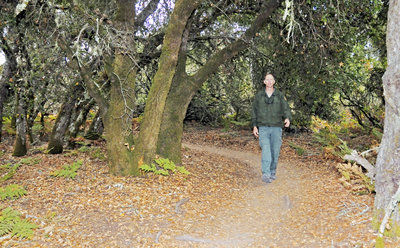
As I drove the 2,000-mile round trip to go rafting in Utah, I remembered what Tim Hyland had told me before I left.
“Santa Cruz County is so unique,” the state parks environmental scientist said. “In just a few miles, you can go through so many ecosystems — riparian, sand hills, conifers. Other places, you can drive for thousands of acres and the ecosystem stays the same.”
In the mountains of Utah, I traveled for hours through pinyon-juniper forests, 8 million acres of them. After a day of rafting on the Colorado River, I pitched my tent by their twisted beauty. Even in the high desert, it’s all about location, location, location.
Also growing along the river were native cottonwood trees and Mormon tea (ephedra), which provided a little zing to the faithful, who were prohibited from consuming caffeine. As in our own ecosystems, though, invasive, nonnative species have unbalanced nature in many western states.
While Tim and other land managers within our district battle French broom, periwinkle and Himalayan blackberry, elsewhere a battle has been waged against tamarisk, which soaks up light, water and nutrients and destroys native wildlife habitat.
After 20 years of study by the U.S. Department of Agriculture, an introduced biological control agent has been released on test sites (including some in California) within the 1.6 million acres of affected areas: the tamarisk beetle. Along the Colorado River, I saw great patches of tamarisk that looked as if they had been blowtorched, the results of a beetle no bigger than Roosevelt’s jaw on a dime.
Unfortunately for Tim, no silver-bullet biological control agent has been approved for our nonnative and invasive plants. So the park system continues to use Monsanto’s Roundup, which has side effects. In 2010, Monsanto’s herbicide sales have dropped 56 percent, due to problems with increasing weed resistance and human health concerns.
Growing up in San Jose, Tim remembers making forts in the orchards, scrambling through mustard plants and watching the sky darken with clouds of cedar waxwings that got drunk from eating pyracantha berries. “The Valley of the Heart’s Delight” is now buried under Silicon Valley, but soon, flocks of cedar waxwings will be flying in to dine on the madrone trees’ red berries.
In fact, the fall migration is Aug. 15 through Oct. 31, when more than 250 bird species will be on the wing.
Audubon California says, “Each year, millions of birds stop over on the Pacific Flyway — a superhighway for birds migrating between Alaska and Patagonia — making California one of the most important areas for migratory birds on the west coast of the Americas.”
You never know who you will meet in the forest this time of year, so Tim and I decided to lead a walk through the recently acquired sand hills and other ecosystems of Henry Cowell Redwoods State Park on Sept. 25. E-mail me for more information.
We will be celebrating the autumn equinox, which falls on Sept. 23, too, so if you would like to share a poem or other reading commemorating this special time of the year, please do.
This nature walk is sponsored by a grant from the San Lorenzo Valley Water District.
Our walk will begin at an unmarked, backdoor entrance to Henry Cowell state park. Guided by Tim, we will follow unnamed trails around the silverleaf manzanita chaparral, known as an “elfin forest,” because plants seldom grow higher than 3 to 8 feet tall in the inhospitable climate of ancient marine sand deposits. The silverleaf manzanita is recognized by the California Native Plant Society as among the most rare and endangered plant species in the state due to habitat urbanization.
Our walk will take us through another “biological island” — the Ponderosa pine park land. I think of Ponderosa pines as the “mosaic” tree, because of their decoratively plated bark. One of the mysteries of our many ecosystems: How did the Ponderosa develop in the park at less than 800 feet, when they usually grow in the Sierra Nevada at 3,000 feet?
Carol Carson is an environmentalist and writes a nature column for the Press Banner. She has a master’s degree in education and has been a docent for Henry Cowell Redwoods State Park and taught courses on Big Basin State Park for UCSC Extension. She can be contacted at ca****@*********on.com.












